Microsoft Azure Developer Certification Transition v1.0
Question 1
Case study -
This is a case study. Case studies are not timed separately. You can use as much exam time as you would like to complete each case. However, there may be additional case studies and sections on this exam. You must manage your time to ensure that you are able to complete all questions included on this exam in the time provided.
To answer the questions included in a case study, you will need to reference information that is provided in the case study. Case studies might contain exhibits and other resources that provide more information about the scenario that is described in the case study. Each question is independent of the other question on this case study.
At the end of this case study, a review screen will appear. This screen allows you to review your answers and to make changes before you move to the next sections of the exam. After you begin a new section, you cannot return to this section.
To start the case study -
To display the first question on this case study, click the Next button. Use the buttons in the left pane to explore the content of the case study before you answer the questions. Clicking these buttons displays information such as business requirements, existing environment, and problem statements. If the case study has an
All Information tab, note that the information displayed is identical to the information displayed on the subsequent tabs. When you are ready to answer a question, click the Question button to return to the question.
Background -
Best for You Organics Company is a global restaurant franchise that has multiple locations. The company wants to enhance user experiences and vendor integrations. The company plans to implement automated mobile ordering and delivery services.
Best For You Organics hosts an Azure web app at the URL https://www.bestforyouorganics.com.
Users can use the web app to browse restaurant locations, menu items, nutritional, information, and company information. The company developed and deployed a cross-platform mobile app.
Requirements -
You must develop a chartbot by using the Bot Builder SDK and Language Understanding Intelligence Service (LUIS). The chatbot must allow users to order food for pickup or delivery.
The chatbot must meet the following requirements:
Ensure that chatbot endpoint can be accessed only by the Bot Framework connector.
Use natural language processing and speech recognition so that users can interact with the chatbot by using text and voice. Processing must be server-based.
Alert users about promotions at local restaurants.
Enable users to place an order for delivery or pickup by using their voice.
Greet the user upon sigh-in by displaying a graphical interface that contains action buttons.

The chatbot greeting interface must match the formatting of the following example:
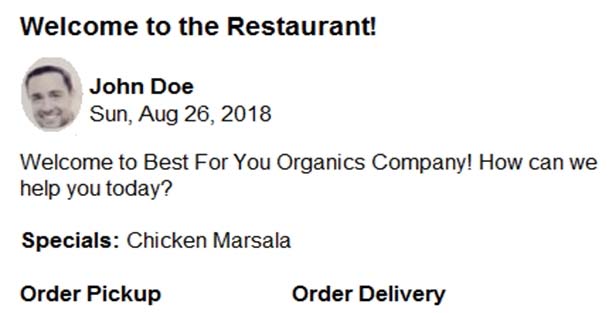
Vendor API -
Vendors receive and provide updates for the restaurant inventory and delivery services by using Azure API Management hosted APIs. Each vendor uses their own subscription to access each of the APIs.
APIs must meet the following conditions:
API usage must not exceed 5,000 calls and 50,000 kilobytes of bandwidth per hour per vendor.
If a vendor is nearing the number of calls or bandwidth limit, the API must trigger email notifications to the vendor.
APIs must prevent API usage spikes on a per-subscription basis by limiting the call rate to 100 calls per minute.
The Inventory API must be written by using ASP.NET Core and Node.js.
The API must be updated to provide an interface to Azure SQL Database. Database objects must be managed by using code.
The Delivery API must be protected by using the OAuth 2.0 protocol with Azure Active Directory (Azure AD) when called from the Azure web app. You register the Delivery API and web app in Azure AD. You enable OAuth 2.0 in the web app.
The delivery API must update the Products table, the Vendor transactions table, and the Billing table in a single transaction.
The Best For You Organics Company architecture team has created the following diagram depicting the expected deployments into Azure:
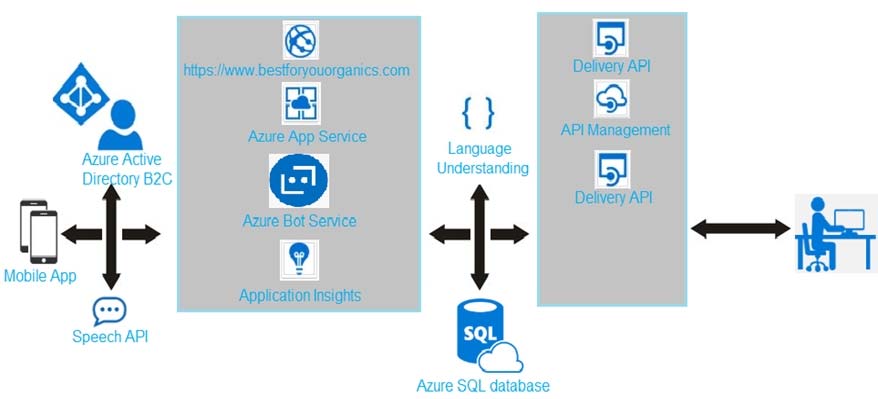
Delivery API -
The Delivery API intermittently throws the following exception:

Chatbot greeting -
The chatbot"™s greeting does not show the user"™s name. You need to debug the chatbot locally.
Language processing -
Users report that the bot fails to understand when a customer attempts to order dishes that use Italian names.
Relevant portions of the app files are shown below. Line numbers are included for reference only and include a two-character prefix that denotes the specific file to which they belong.
Startup.cs -
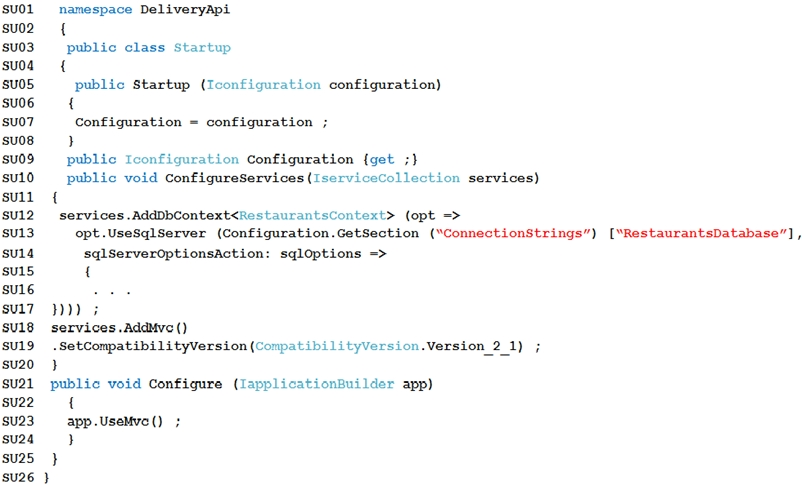
HOTSPOT -
You need to update the Inventory API.
Which development tools should you use? To answer, select the appropriate options in the answer area.
NOTE: Each correct selection is worth one point.
Hot Area:
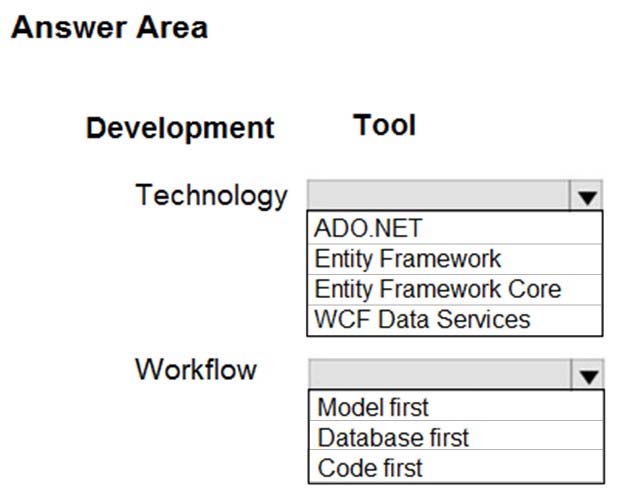
Answer : 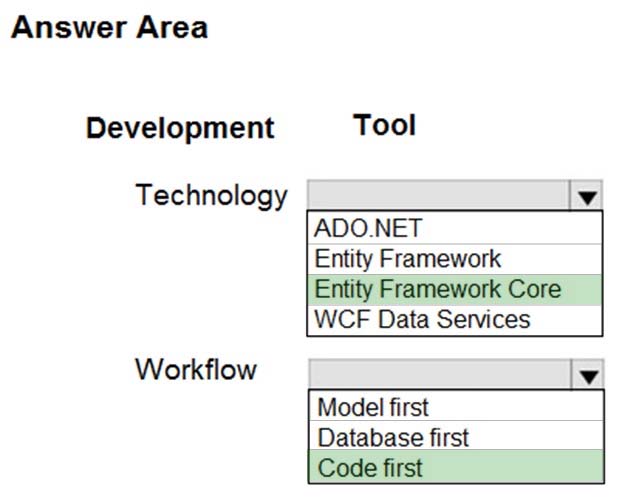
Explanation:
Scenario: The Inventory API must be written by using ASP.NET Core and Node.js.
Box 1: Entity Framework Core -
Box 2: Code first -
References:
https://docs.microsoft.com/en-us/aspnet/mvc/overview/getting-started/getting-started-with-ef-using-mvc/creating-an-entity-framework-data-model-for-an-asp-net- mvc-application
Question 2
Case Study -
This is a case study. Case studies are not timed separately. You can use as much exam time as you would like to complete each case. However, there may be additional case studies and sections on this exam. You must manage your time to ensure that you are able to complete all questions included on this exam in the time provided.
To answer the questions included in a case study, you will need to reference information that is provided in the case study. Case studies might contain exhibits and other resources that provide more information about the scenario that is described in the case study. Each question is independent of the other question on this case study.
At the end of this case study, a review screen will appear. This screen allows you to review your answers and to make changes before you move to the next sections of the exam. After you begin a new section, you cannot return to this section.
To start the case study -
To display the first question on this case study, click the Next button. Use the buttons in the left pane to explore the content of the case study before you answer the questions. Clicking these buttons displays information such as business requirements, existing environment, and problem statements. If the case study has an
All Information tab, note that the information displayed is identical to the information displayed on the subsequent tabs. When you are ready to answer a question, click the Question button to return to the question.
Background -
You are a developer for Litware Inc., a SaaS company that provides a solution for managing employee expenses. The solution consists of an ASP.NET Core Web
API project that is deployed as an Azure Web App.
Overall architecture -
Employees upload receipts for the system to process. When processing is complete, the employee receives a summary report email that details the processing results. Employees then use a web application to manager their receipts and perform any additional tasks needed for reimbursement.
Receipt processing -
Employees may upload receipts in two ways:
Uploading using an Azure Files mounted folder
Uploading using the web application
Data Storage -
Receipt and employee information is stored in an Azure SQL database.
Documentation -
Employees are provided with a getting started document when they first use the solution. The documentation includes details on supported operating systems for
Azure File upload, and instructions on how to configure the mounted folder.
Solution details -
Users table -

Web Application -
You enable MSI for the Web App and configure the Web App to use the security principal name.
Processing -
Processing is performed by an Azure Function that uses version 2 of the Azure Function runtime. Once processing is completed, results are stored in Azure Blob
Storage and an Azure SQL database. Then, an email summary is sent to the user with a link to the processing report. The link to the report must remain valid if the email is forwarded to another user.
Requirements -
Receipt processing -
Concurrent processing of a receipt must be prevented.
Logging -
Azure Application Insights is used for telemetry and logging in both the processor and the web application. The processor also has TraceWriter logging enabled.
Application Insights must always contain all log messages.
Disaster recovery -
Regional outage must not impact application availability. All DR operations must not be dependent on application running and must ensure that data in the DR region is up to date.
Security -
Users"™ SecurityPin must be stored in such a way that access to the database does not allow the viewing of SecurityPins. The web application is the only system that should have access to SecurityPins.
All certificates and secrets used to secure data must be stored in Azure Key Vault.
You must adhere to the Least Privilege Principal.
All access to Azure Storage and Azure SQL database must use the application"™s Managed Service Identity (MSI)
Receipt data must always be encrypted at rest.
All data must be protected in transit.
User"™s expense account number must be visible only to logged in users. All other views of the expense account number should include only the last segment with the remaining parts obscured.
In the case of a security breach, access to all summary reports must be revoked without impacting other parts of the system.
Issues -
Upload format issue -
Employees occasionally report an issue with uploading a receipt using the web application. They report that when they upload a receipt using the Azure File
Share, the receipt does not appear in their profile. When this occurs, they delete the file in the file share and use the web application, which returns a 500 Internal
Server error page.
Capacity issue -
During busy periods, employees report long delays between the time they upload the receipt and when it appears in the web application.
Log capacity issue -
Developers report that the number of log messages in the trace output for the processor is too high, resulting in lost log messages.
Processing.cs -
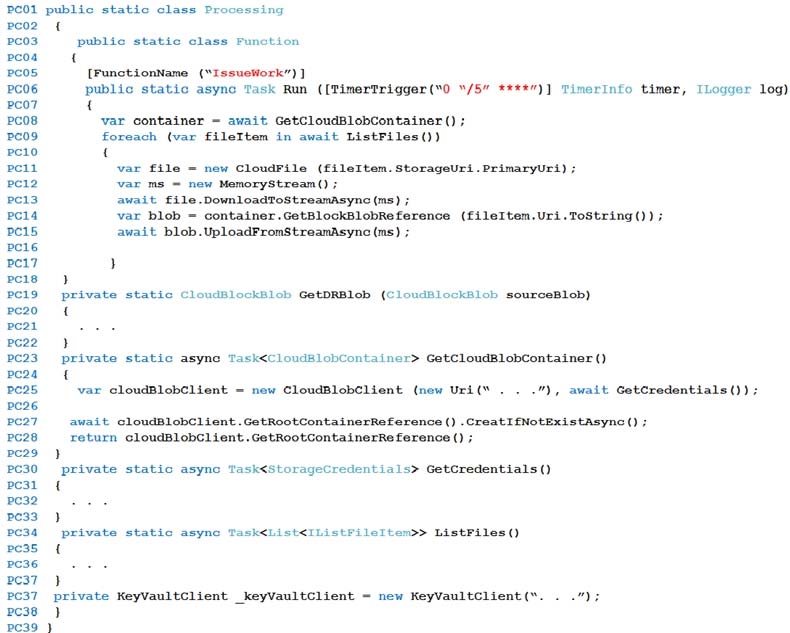
Database.cs -
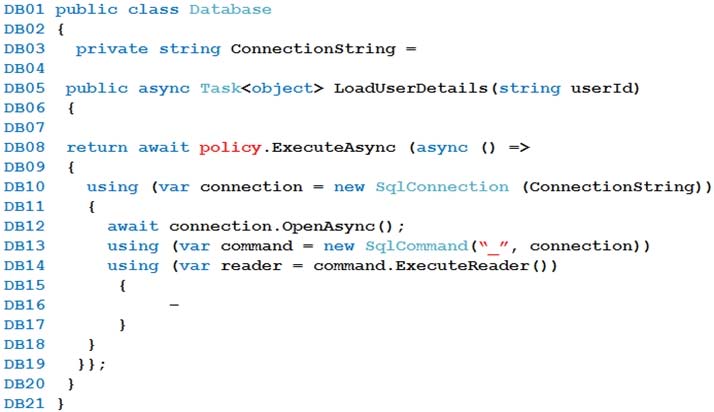
ReceiptUploader.cs -
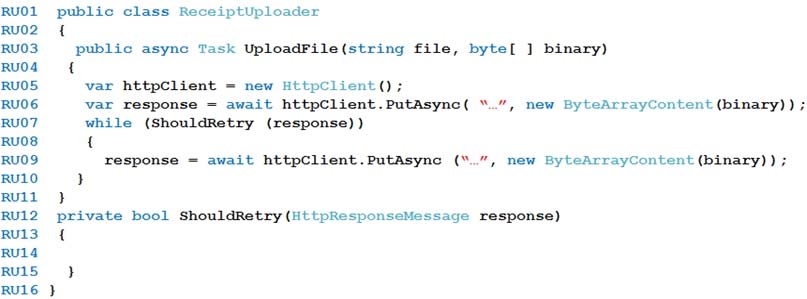
ConfigureSSE.ps1 -
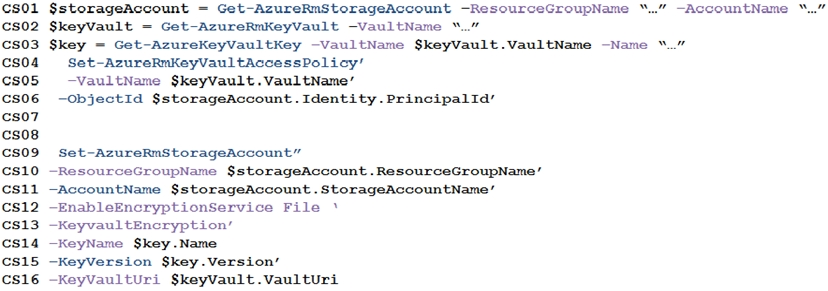
HOTSPOT -
You need to configure retries in the LoadUserDetails function in the Database class without impacting user experience.
What code, should you insert on line DB07?
To answer, select the appropriate options in the answer area.
NOTE: Each correct selection is worth one point.
Hot Area:
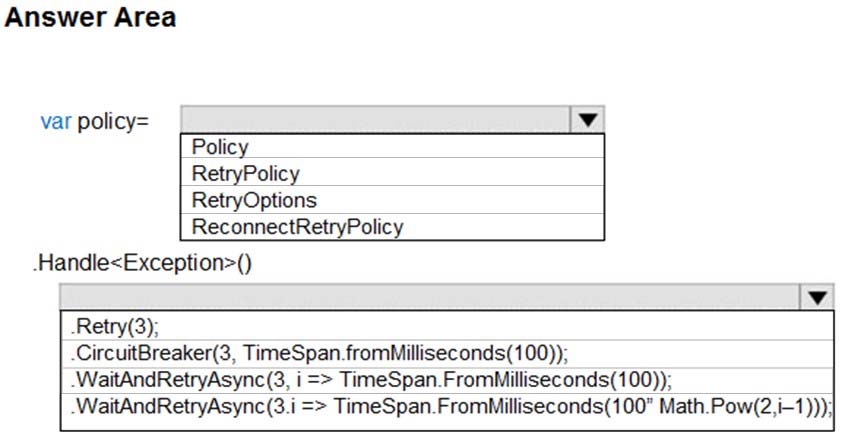
Answer : 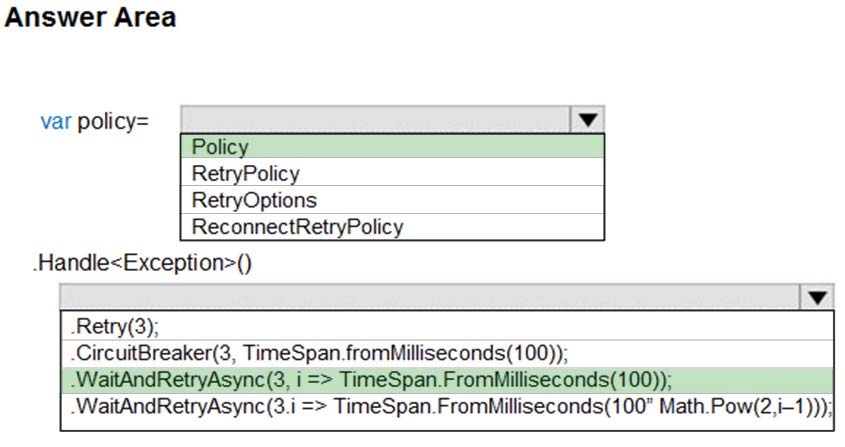
Explanation:
Box 1: Policy -
RetryPolicy retry = Policy -
.Handle<HttpRequestException>()
.Retry(3);
The above example will create a retry policy which will retry up to three times if an action fails with an exception handled by the Policy.
Box 2: WaitAndRetryAsync(3,i => TimeSpan.FromMilliseconds(100* Math.Pow(2,i-1)));
A common retry strategy is exponential backoff: this allows for retries to be made initially quickly, but then at progressively longer intervals, to avoid hitting a subsystem with repeated frequent calls if the subsystem may be struggling.
Example:
Policy -
.Handle<SomeExceptionType>()
.WaitAndRetry(3, retryAttempt =>
TimeSpan.FromSeconds(Math.Pow(2, retryAttempt))
);
References:
https://github.com/App-vNext/Polly/wiki/Retry
Question 3
DRAG DROP -
You develop a web app that uses the tier D1 app service plan by using the Web Apps feature of Microsoft Azure App Service.
Spikes in traffic have caused increases in page load times.
You need to ensure that the web app automatically scales when CPU load is about 85 percent and minimize costs.
Which four actions should you perform in sequence? To answer, move the appropriate actions from the list of actions to the answer area and arrange them in the correct order.
NOTE: Each correct selection is worth one point.
Select and Place:

Answer : 
Explanation:
Step 1: Configure the web app to the Standard App Service Tier
The Standard tier supports auto-scaling, and we should minimize the cost.
Step 2: Enable autoscaling on the web app
First enable autoscale -
Step 3: Add a scale rule -
Step 4: Add a Scale condidation -
References:
https://docs.microsoft.com/en-us/azure/monitoring-and-diagnostics/monitoring-autoscale-get-started https://azure.microsoft.com/en-us/pricing/details/app-service/plans/
Question 4
DRAG DROP -
You are developing a multi-tenant ASP.NET Core application that will be hosted on Azure. The application will support multiple database platforms, including
Azure SQL and on-premises SQL Server instances.
You need to ensure the application supports distributed transactions.
Which technologies should you use? To answer, drag the appropriate technologies to the correct scenarios. Each technology may be used once, more than once, or not at all. You may need to drag the split bar between panes or scroll to view content.
NOTE: Each correct selection is worth one point.
Select and Place:

Answer : 
Explanation:
Box 1: Elastic Database Client Library
Sharded database applications in Azure: With this scenario, the data tier uses the Elastic Database client library or self-sharding to horizontally partition the data across many databases in SQL DB.
Box 2: MSDTC -
Eelastic database transactions cannot stretch across on premises SQL Server and Azure SQL Database. For distributed transactions on premises, continue to use MSDTC.
References:
https://docs.microsoft.com/en-us/azure/sql-database/sql-database-elastic-transactions-overview
Question 5
You have implemented code that uses elastic transactions spanning across three different Azure SQL Database logical servers.
Database administration report that some transactions take longer to complete than expected.
You need to use the correct tool to monitor all the transactions originating from the elastic transaction implementation.
Which tool should you use?
- A. Use the dependencies section of Azure Applications Insights.
- B. Run the sys.dm_tran_active_transactions dynamic management view.
- C. Run the sys.dm_tran_current_snapshot dynamic management view.
- D. Run the sys.dm_tran_active_snapshot_database_transactions dynamic management view.
Answer : B
Explanation:
Use Dynamic Management Views (DMVs) in SQL DB to monitor status and progress of your ongoing elastic database transactions.
These DMVs are particularly useful:
sys.dm_tran_active_transactions: Lists currently active transactions and their status. The UOW (Unit Of Work) column can identify the different child transactions that belong to the same distributed transaction. All transactions within the same distributed transaction carry the same UOW value. sys.dm_tran_database_transactions: Provides additional information about transactions, such as placement of the transaction in the log. sys.dm_tran_locks: Provides information about the locks that are currently held by ongoing transactions
References:
https://docs.microsoft.com/en-us/azure/sql-database/sql-database-elastic-transactions-overview
Question 6
A company is migrating an existing on-premises third-party website to Azure. The website is stateless.
The company does not have access to the source code for the website. They do have the original installer.
The number of visitors at the website varies throughout the year. The on-premises infrastructure was resized to accommodate peaks but the extra capacity was not used.
You need to implement a virtual machine scale set instance.
What should you do?
- A. Use an autoscale setting to scale instances vertically.
- B. Use an autoscale setting with unlimited maximum number of instances.
- C. Scale out by one instance when the average CPU usage of one of the instance is over 80 percent.
- D. Use Azure Monitor to create autoscale settings using custom metrics.
Answer : D
Explanation:
Azure Monitor autoscaling allows you to scale the number of running instances up or down, based on telemetry data (metrics).
References:
https://docs.microsoft.com/en-us/azure/monitoring-and-diagnostics/insights-autoscale-common-metrics
Question 7
DRAG DROP -
You are implementing an order processing system. A point of sale application publishes orders to topics in an Azure Service Bus queue. The label property for the topic includes the following data:

The system has the following requirements for subscriptions:
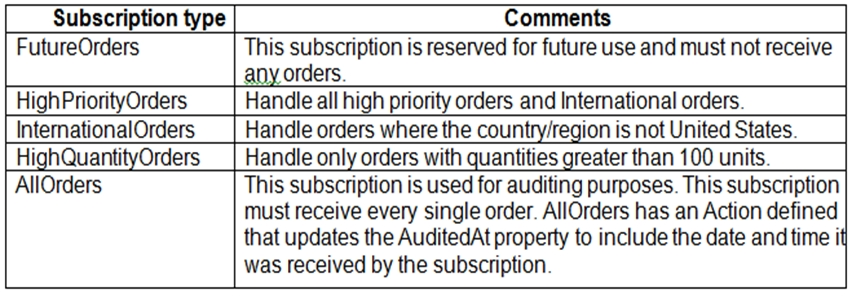
You need to implement filtering and maximize throughput while evaluating filters.
Which filter types should you implement? To answer, drag the appropriate filter types to the correct subscriptions. Each filter type may be used once, more than once, or not at all. You may need to drag the split bar between panes or scroll to view content.
NOTE: Each correct selection is worth one point.
Select and Place:
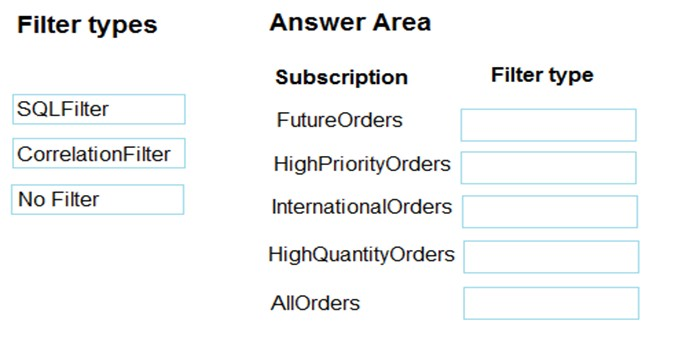
Answer : 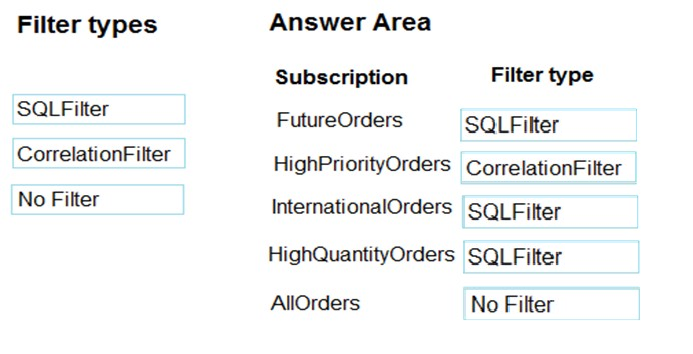
Explanation:
FutureOrders: SQLFilter -
HighPriortyOrders: CorrelationFilter
CorrelationID only -
InternationalOrders: SQLFilter -
Country NOT USA requires an SQL Filter
HighQuantityOrders: SQLFilter -
Need to use relational operators so an SQL Filter is needed.
AllOrders: No Filter -
SQL Filter: SQL Filters - A SqlFilter holds a SQL-like conditional expression that is evaluated in the broker against the arriving messages' user-defined properties and system properties. All system properties must be prefixed with sys. in the conditional expression. The SQL-language subset for filter conditions tests for the existence of properties (EXISTS), as well as for null-values (IS NULL), logical NOT/AND/OR, relational operators, simple numeric arithmetic, and simple text pattern matching with LIKE.
Correlation Filters - A CorrelationFilter holds a set of conditions that are matched against one or more of an arriving message's user and system properties. A common use is to match against the CorrelationId property, but the application can also choose to match against ContentType, Label, MessageId, ReplyTo,
ReplyToSessionId, SessionId, To, and any user-defined properties. A match exists when an arriving message's value for a property is equal to the value specified in the correlation filter. For string expressions, the comparison is case-sensitive. When specifying multiple match properties, the filter combines them as a logical
AND condition, meaning for the filter to match, all conditions must match.
Boolean filters - The TrueFilter and FalseFilter either cause all arriving messages (true) or none of the arriving messages (false) to be selected for the subscription.
References:
https://docs.microsoft.com/en-us/azure/service-bus-messaging/topic-filters
Question 8
You are developing an Azure Batch solution to perform CPU intensive calculations. The calculations occur at a specific time each week and last for approximately one hour.
Before any changes are made, a timer must be created to measure the initial duration. The timer must start before the first calculation is queued to run on the computer node.
You need to implement the timer.
Before which line should the timer be created?
- A. CloudJob = batchClient.JobOperations.CreateJob();
- B. batchClient.JobOperations.AddTask(JobId, tasks);
- C. batchClient.Utilities.CreateTaskStateMonitor().WaitAll(addedTasks, TaskState.Completed, timeout);
- D. using (BatchClient batchClient = BatchClient.Open(cred))
Answer : B
References:
https://docs.microsoft.com/en-us/azure/batch/quick-run-dotnet
Question 9
Case study -
This is a case study. Case studies are not timed separately. You can use as much exam time as you would like to complete each case. However, there may be additional case studies and sections on this exam. You must manage your time to ensure that you are able to complete all questions included on this exam in the time provided.
To answer the questions included in a case study, you will need to reference information that is provided in the case study. Case studies might contain exhibits and other resources that provide more information about the scenario that is described in the case study. Each question is independent of the other question on this case study.
At the end of this case study, a review screen will appear. This screen allows you to review your answers and to make changes before you move to the next sections of the exam. After you begin a new section, you cannot return to this section.
To start the case study -
To display the first question on this case study, click the Next button. Use the buttons in the left pane to explore the content of the case study before you answer the questions. Clicking these buttons displays information such as business requirements, existing environment, and problem statements. If the case study has an
All Information tab, note that the information displayed is identical to the information displayed on the subsequent tabs. When you are ready to answer a question, click the Question button to return to the question.
Background -
Best for You Organics Company is a global restaurant franchise that has multiple locations. The company wants to enhance user experiences and vendor integrations. The company plans to implement automated mobile ordering and delivery services.
Best For You Organics hosts an Azure web app at the URL https://www.bestforyouorganics.com.
Users can use the web app to browse restaurant locations, menu items, nutritional, information, and company information. The company developed and deployed a cross-platform mobile app.
Requirements -
You must develop a chartbot by using the Bot Builder SDK and Language Understanding Intelligence Service (LUIS). The chatbot must allow users to order food for pickup or delivery.
The chatbot must meet the following requirements:
Ensure that chatbot endpoint can be accessed only by the Bot Framework connector.
Use natural language processing and speech recognition so that users can interact with the chatbot by using text and voice. Processing must be server-based.
Alert users about promotions at local restaurants.
Enable users to place an order for delivery or pickup by using their voice.
Greet the user upon sign-in by displaying a graphical interface that contains action buttons.

The chatbot greeting interface must match the formatting of the following example:
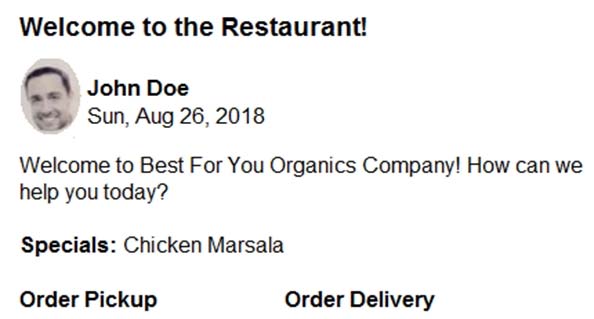
Vendor API -
Vendors receive and provide updates for the restaurant inventory and delivery services by using Azure API Management hosted APIs. Each vendor uses their own subscription to access each of the APIs.
APIs must meet the following conditions:
API usage must not exceed 5,000 calls and 50,000 kilobytes of bandwidth per hour per vendor.
If a vendor is nearing the number of calls or bandwidth limit, the API must trigger email notifications to the vendor.
APIs must prevent API usage spikes on a per-subscription basis by limiting the call rate to 100 calls per minute.
The Inventory API must be written by using ASP.NET Core and Node.js.
The API must be updated to provide an interface to Azure SQL Database. Database objects must be managed by using code.
The Delivery API must be protected by using the OAuth 2.0 protocol with Azure Active Directory (Azure AD) when called from the Azure web app. You register the Delivery API and web app in Azure AD. You enable OAuth 2.0 in the web app.
The delivery API must update the Products table, the Vendor transactions table, and the Billing table in a single transaction.
The Best For You Organics Company architecture team has created the following diagram depicting the expected deployments into Azure:
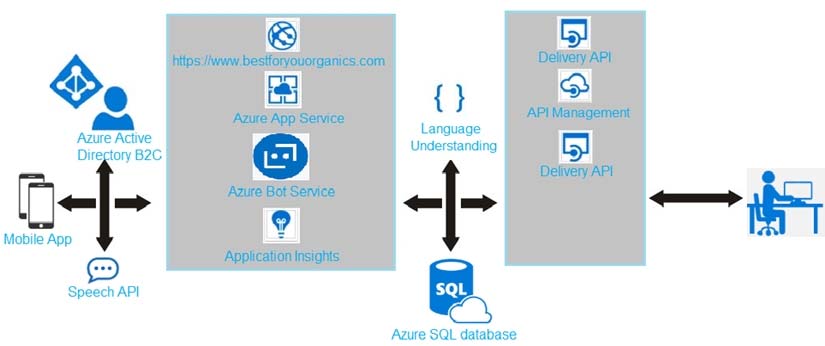
Delivery API -
The Delivery API intermittently throws the following exception:

Chatbot greeting -
The chatbot"™s greeting does not show the user"™s name. You need to debug the chatbot locally.
Language processing -
Users report that the bot fails to understand when a customer attempts to order dishes that use Italian names.
Relevant portions of the app files are shown below. Line numbers are included for reference only and include a two-character prefix that denotes the specific file to which they belong.
Startup.cs -
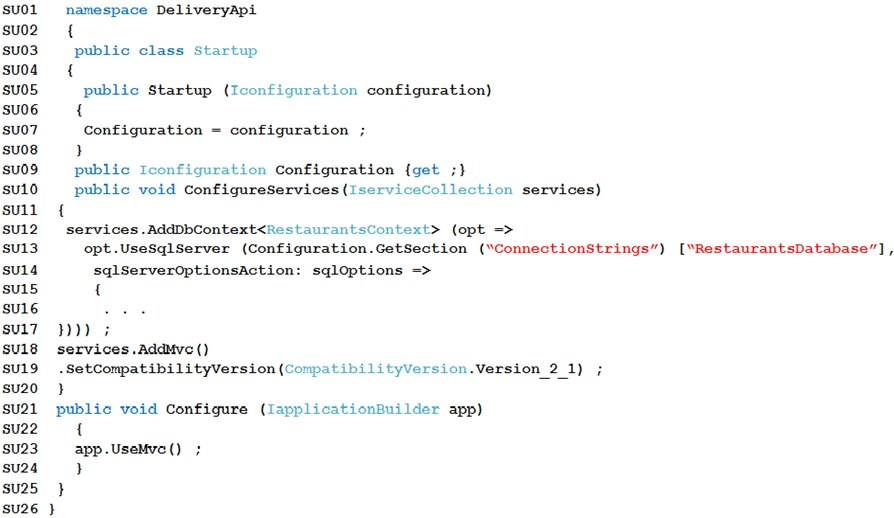
Note: In this section you will see one or more sets of questions with the same scenario and problem. Each question presents a unique solution to the problem, and you must determine whether the solution meets the stated goals. More than one solution might solve the problem. It is also possible that none of the solutions solve the problem.
After you answer a question in this section, you will NOT be able to return to it. As a result, these questions will not appear in the review screen.
Note: This question is part of a series of questions that present the same scenario. Each question in the series contains a unique solution. Determine whether the solution meets the stated goals.
You need to meet the vendor notification requirement.
Solution: Create and apply a custom outbound Azure API Management policy.
Does the solution meet the goal?
- A. Yes
- B. No
Answer : A
Explanation:
Scenario:
If a vendor is nearing the number of calls or bandwidth limit, the API must trigger email notifications to the vendor.
(API usage must not exceed 5,000 calls and 50,000 kilobytes of bandwidth per hour per vendor.)
In Azure API Management (APIM), policies are a powerful capability of the system that allow the publisher to change the behavior of the API through configuration.
Policies are a collection of Statements that are executed sequentially on the request or response of an API. Popular Statements include format conversion from
XML to JSON and call rate limiting to restrict the amount of incoming calls from a developer. Many more policies are available out of the box.
References:
https://docs.microsoft.com/en-us/azure/api-management/api-management-howto-policies
Question 10
Case study -
This is a case study. Case studies are not timed separately. You can use as much exam time as you would like to complete each case. However, there may be additional case studies and sections on this exam. You must manage your time to ensure that you are able to complete all questions included on this exam in the time provided.
To answer the questions included in a case study, you will need to reference information that is provided in the case study. Case studies might contain exhibits and other resources that provide more information about the scenario that is described in the case study. Each question is independent of the other question on this case study.
At the end of this case study, a review screen will appear. This screen allows you to review your answers and to make changes before you move to the next sections of the exam. After you begin a new section, you cannot return to this section.
To start the case study -
To display the first question on this case study, click the Next button. Use the buttons in the left pane to explore the content of the case study before you answer the questions. Clicking these buttons displays information such as business requirements, existing environment, and problem statements. If the case study has an
All Information tab, note that the information displayed is identical to the information displayed on the subsequent tabs. When you are ready to answer a question, click the Question button to return to the question.
Background -
Best for You Organics Company is a global restaurant franchise that has multiple locations. The company wants to enhance user experiences and vendor integrations. The company plans to implement automated mobile ordering and delivery services.
Best For You Organics hosts an Azure web app at the URL https://www.bestforyouorganics.com.
Users can use the web app to browse restaurant locations, menu items, nutritional, information, and company information. The company developed and deployed a cross-platform mobile app.
Requirements -
You must develop a chartbot by using the Bot Builder SDK and Language Understanding Intelligence Service (LUIS). The chatbot must allow users to order food for pickup or delivery.
The chatbot must meet the following requirements:
Ensure that chatbot endpoint can be accessed only by the Bot Framework connector.
Use natural language processing and speech recognition so that users can interact with the chatbot by using text and voice. Processing must be server-based.
Alert users about promotions at local restaurants.
Enable users to place an order for delivery or pickup by using their voice.
Greet the user upon sign-in by displaying a graphical interface that contains action buttons.

The chatbot greeting interface must match the formatting of the following example:

Vendor API -
Vendors receive and provide updates for the restaurant inventory and delivery services by using Azure API Management hosted APIs. Each vendor uses their own subscription to access each of the APIs.
APIs must meet the following conditions:
API usage must not exceed 5,000 calls and 50,000 kilobytes of bandwidth per hour per vendor.
If a vendor is nearing the number of calls or bandwidth limit, the API must trigger email notifications to the vendor.
APIs must prevent API usage spikes on a per-subscription basis by limiting the call rate to 100 calls per minute.
The Inventory API must be written by using ASP.NET Core and Node.js.
The API must be updated to provide an interface to Azure SQL Database. Database objects must be managed by using code.
The Delivery API must be protected by using the OAuth 2.0 protocol with Azure Active Directory (Azure AD) when called from the Azure web app. You register the Delivery API and web app in Azure AD. You enable OAuth 2.0 in the web app.
The delivery API must update the Products table, the Vendor transactions table, and the Billing table in a single transaction.
The Best For You Organics Company architecture team has created the following diagram depicting the expected deployments into Azure:

Delivery API -
The Delivery API intermittently throws the following exception:

Chatbot greeting -
The chatbot"™s greeting does not show the user"™s name. You need to debug the chatbot locally.
Language processing -
Users report that the bot fails to understand when a customer attempts to order dishes that use Italian names.
Relevant portions of the app files are shown below. Line numbers are included for reference only and include a two-character prefix that denotes the specific file to which they belong.
Startup.cs -

Note: In this section you will see one or more sets of questions with the same scenario and problem. Each question presents a unique solution to the problem, and you must determine whether the solution meets the stated goals. More than one solution might solve the problem. It is also possible that none of the solutions solve the problem.
After you answer a question in this section, you will NOT be able to return to it. As a result, these questions will not appear in the review screen.
Note: This question is part of a series of questions that present the same scenario. Each question in the series contains a unique solution. Determine whether the solution meets the stated goals.
You need to meet the vendor notification requirement.
Solution: Update the Delivery API to send emails by using a Microsoft Office 365 SMTP server.
Does the solution meet the goal?
- A. Yes
- B. No
Answer : B
Explanation:
Use a custom outbound Azure API Management policy.
Scenario:
If a vendor is nearing the number of calls or bandwidth limit, the API must trigger email notifications to the vendor.
(API usage must not exceed 5,000 calls and 50,000 kilobytes of bandwidth per hour per vendor.)
References:
https://docs.microsoft.com/en-us/azure/api-management/api-management-howto-policies
Question 11
Case study -
This is a case study. Case studies are not timed separately. You can use as much exam time as you would like to complete each case. However, there may be additional case studies and sections on this exam. You must manage your time to ensure that you are able to complete all questions included on this exam in the time provided.
To answer the questions included in a case study, you will need to reference information that is provided in the case study. Case studies might contain exhibits and other resources that provide more information about the scenario that is described in the case study. Each question is independent of the other question on this case study.
At the end of this case study, a review screen will appear. This screen allows you to review your answers and to make changes before you move to the next sections of the exam. After you begin a new section, you cannot return to this section.
To start the case study -
To display the first question on this case study, click the Next button. Use the buttons in the left pane to explore the content of the case study before you answer the questions. Clicking these buttons displays information such as business requirements, existing environment, and problem statements. If the case study has an
All Information tab, note that the information displayed is identical to the information displayed on the subsequent tabs. When you are ready to answer a question, click the Question button to return to the question.
Background -
Best for You Organics Company is a global restaurant franchise that has multiple locations. The company wants to enhance user experiences and vendor integrations. The company plans to implement automated mobile ordering and delivery services.
Best For You Organics hosts an Azure web app at the URL https://www.bestforyouorganics.com.
Users can use the web app to browse restaurant locations, menu items, nutritional, information, and company information. The company developed and deployed a cross-platform mobile app.
Requirements -
You must develop a chartbot by using the Bot Builder SDK and Language Understanding Intelligence Service (LUIS). The chatbot must allow users to order food for pickup or delivery.
The chatbot must meet the following requirements:
Ensure that chatbot endpoint can be accessed only by the Bot Framework connector.
Use natural language processing and speech recognition so that users can interact with the chatbot by using text and voice. Processing must be server-based.
Alert users about promotions at local restaurants.
Enable users to place an order for delivery or pickup by using their voice.
Greet the user upon sign-in by displaying a graphical interface that contains action buttons.

The chatbot greeting interface must match the formatting of the following example:

Vendor API -
Vendors receive and provide updates for the restaurant inventory and delivery services by using Azure API Management hosted APIs. Each vendor uses their own subscription to access each of the APIs.
APIs must meet the following conditions:
API usage must not exceed 5,000 calls and 50,000 kilobytes of bandwidth per hour per vendor.
If a vendor is nearing the number of calls or bandwidth limit, the API must trigger email notifications to the vendor.
APIs must prevent API usage spikes on a per-subscription basis by limiting the call rate to 100 calls per minute.
The Inventory API must be written by using ASP.NET Core and Node.js.
The API must be updated to provide an interface to Azure SQL Database. Database objects must be managed by using code.
The Delivery API must be protected by using the OAuth 2.0 protocol with Azure Active Directory (Azure AD) when called from the Azure web app. You register the Delivery API and web app in Azure AD. You enable OAuth 2.0 in the web app.
The delivery API must update the Products table, the Vendor transactions table, and the Billing table in a single transaction.
The Best For You Organics Company architecture team has created the following diagram depicting the expected deployments into Azure:

Delivery API -
The Delivery API intermittently throws the following exception:

Chatbot greeting -
The chatbot"™s greeting does not show the user"™s name. You need to debug the chatbot locally.
Language processing -
Users report that the bot fails to understand when a customer attempts to order dishes that use Italian names.
Relevant portions of the app files are shown below. Line numbers are included for reference only and include a two-character prefix that denotes the specific file to which they belong.
Startup.cs -

Note: In this section you will see one or more sets of questions with the same scenario and problem. Each question presents a unique solution to the problem, and you must determine whether the solution meets the stated goals. More than one solution might solve the problem. It is also possible that none of the solutions solve the problem.
After you answer a question in this section, you will NOT be able to return to it. As a result, these questions will not appear in the review screen.
Note: This question is part of a series of questions that present the same scenario. Each question in the series contains a unique solution. Determine whether the solution meets the stated goals.
You need to meet the vendor notification requirement.
Solution: Configure notifications in the Azure API Management instance.
Does the solution meet the goal?
- A. Yes
- B. No
Answer : B
Explanation:
Use a custom outbound Azure API Management policy.
Scenario:
If a vendor is nearing the number of calls or bandwidth limit, the API must trigger email notifications to the vendor.
(API usage must not exceed 5,000 calls and 50,000 kilobytes of bandwidth per hour per vendor.)
References:
https://docs.microsoft.com/en-us/azure/api-management/api-management-howto-policies
Question 12
Case study -
This is a case study. Case studies are not timed separately. You can use as much exam time as you would like to complete each case. However, there may be additional case studies and sections on this exam. You must manage your time to ensure that you are able to complete all questions included on this exam in the time provided.
To answer the questions included in a case study, you will need to reference information that is provided in the case study. Case studies might contain exhibits and other resources that provide more information about the scenario that is described in the case study. Each question is independent of the other question on this case study.
At the end of this case study, a review screen will appear. This screen allows you to review your answers and to make changes before you move to the next sections of the exam. After you begin a new section, you cannot return to this section.
To start the case study -
To display the first question on this case study, click the Next button. Use the buttons in the left pane to explore the content of the case study before you answer the questions. Clicking these buttons displays information such as business requirements, existing environment, and problem statements. If the case study has an
All Information tab, note that the information displayed is identical to the information displayed on the subsequent tabs. When you are ready to answer a question, click the Question button to return to the question.
Background -
Best for You Organics Company is a global restaurant franchise that has multiple locations. The company wants to enhance user experiences and vendor integrations. The company plans to implement automated mobile ordering and delivery services.
Best For You Organics hosts an Azure web app at the URL https://www.bestforyouorganics.com.
Users can use the web app to browse restaurant locations, menu items, nutritional, information, and company information. The company developed and deployed a cross-platform mobile app.
Requirements -
You must develop a chartbot by using the Bot Builder SDK and Language Understanding Intelligence Service (LUIS). The chatbot must allow users to order food for pickup or delivery.
The chatbot must meet the following requirements:
Ensure that chatbot endpoint can be accessed only by the Bot Framework connector.
Use natural language processing and speech recognition so that users can interact with the chatbot by using text and voice. Processing must be server-based.
Alert users about promotions at local restaurants.
Enable users to place an order for delivery or pickup by using their voice.
Greet the user upon sign-in by displaying a graphical interface that contains action buttons.

The chatbot greeting interface must match the formatting of the following example:

Vendor API -
Vendors receive and provide updates for the restaurant inventory and delivery services by using Azure API Management hosted APIs. Each vendor uses their own subscription to access each of the APIs.
APIs must meet the following conditions:
API usage must not exceed 5,000 calls and 50,000 kilobytes of bandwidth per hour per vendor.
If a vendor is nearing the number of calls or bandwidth limit, the API must trigger email notifications to the vendor.
APIs must prevent API usage spikes on a per-subscription basis by limiting the call rate to 100 calls per minute.
The Inventory API must be written by using ASP.NET Core and Node.js.
The API must be updated to provide an interface to Azure SQL Database. Database objects must be managed by using code.
The Delivery API must be protected by using the OAuth 2.0 protocol with Azure Active Directory (Azure AD) when called from the Azure web app. You register the Delivery API and web app in Azure AD. You enable OAuth 2.0 in the web app.
The delivery API must update the Products table, the Vendor transactions table, and the Billing table in a single transaction.
The Best For You Organics Company architecture team has created the following diagram depicting the expected deployments into Azure:

Delivery API -
The Delivery API intermittently throws the following exception:

Chatbot greeting -
The chatbot"™s greeting does not show the user"™s name. You need to debug the chatbot locally.
Language processing -
Users report that the bot fails to understand when a customer attempts to order dishes that use Italian names.
Relevant portions of the app files are shown below. Line numbers are included for reference only and include a two-character prefix that denotes the specific file to which they belong.
Startup.cs -

You need to resolve the delivery API error.
What should you do?
- A. Implement simple retry by using the EnableRetryOnFailure feature of Entity Framework.
- B. Implement exponential backoff by using the EnableRetryOnFailure feature of Entity Framework.
- C. Implement the Circuit Breaker pattern by using the EnbaleRetryOnFailure feature of Entity Framework.
- D. Invoke accustom execution strategy in Entity Framework.
Answer : A
Explanation:
Scenario: The Delivery API intermittently throws the following exception:

A useful method to get rid of this error is to use RETRY LOGIC of Entity Framework 1.1.0 services.AddDbContext<DbContext>(options => options.UseSqlServer('yourconnectionstring', "¦sqlServerOptionsAction: sqlOptions => "¦{ "¦"¦sqlOptions.EnableRetryOnFailure( "¦"¦"¦maxRetryCount: 5, "¦"¦"¦maxRetryDelay: TimeSpan.FromSeconds(30), "¦"¦"¦errorNumbersToAdd: new List<int>() { 19 }); "¦}));
In Retry logic, error 19 is not included. So you have to pass the error code 19 to set retry logic for error code 19.
References:
https://stackoverflow.com/questions/47558062/error-19-physical-connection-error/47559967
Question 13
Case Study -
This is a case study. Case studies are not timed separately. You can use as much exam time as you would like to complete each case. However, there may be additional case studies and sections on this exam. You must manage your time to ensure that you are able to complete all questions included on this exam in the time provided.
To answer the questions included in a case study, you will need to reference information that is provided in the case study. Case studies might contain exhibits and other resources that provide more information about the scenario that is described in the case study. Each question is independent of the other question on this case study.
At the end of this case study, a review screen will appear. This screen allows you to review your answers and to make changes before you move to the next sections of the exam. After you begin a new section, you cannot return to this section.
To start the case study -
To display the first question on this case study, click the Next button. Use the buttons in the left pane to explore the content of the case study before you answer the questions. Clicking these buttons displays information such as business requirements, existing environment, and problem statements. If the case study has an
All Information tab, note that the information displayed is identical to the information displayed on the subsequent tabs. When you are ready to answer a question, click the Question button to return to the question.
Background -
You are a developer for Proseware, Inc. You are developing an application that applies a set of governance policies for Proseware"™s internal services, external services, and applications. The application will also provide a shared library for common functionality.
Requirements -
Policy service -
You develop and deploy a stateful ASP.NET Core 2.1 web application named Policy service to an Azure App Service Web App. The application reacts to events from Azure Event Grid and performs policy actions based on those events.
The application must include the Event Grid Event ID field in all Application Insights telemetry.
Policy service must use Application Insights to automatically scale with the number of policy actions that it is performing.
Policies -
Log Policy -
All Azure App Service Web Apps must write logs to Azure Blob storage. All log files should be saved to a container named logdrop. Logs must remain in the container for 15 days.
Authentication events -
Authentication events are used to monitor users signing in and signing out. All authentication events must be processed by Policy service. Sign outs must be processed as quickly as possible.
PolicyLib -
You have a shared library named PolicyLib that contains functionality common to all ASP.NET Core web services and applications. The PolicyLib library must:
Exclude non-user actions from Application Insights telemetry.
Provide methods that allow a web service to scale itself
Ensure that scaling actions do not disrupt application usage
Other -
Anomaly detection service -
You have an anomaly detection service that analyzes log information for anomalies. It is implemented as an Azure Machine Learning model. The model is deployed as a web service.
If an anomaly is detected, an Azure Function that emails administrators is called by using an HTTP WebHook.
Health monitoring -
All web applications and services have health monitoring at the /health service endpoint.
Policy loss -
When you deploy Policy service, policies may not be applied if they were in the process of being applied during the deployment.
Performance issue -
When under heavy load, the anomaly detection service undergoes slowdowns and rejects connections.
Notification latency -
Users report that anomaly detection emails can sometimes arrive several minutes after an anomaly is detected.
Relevant portions of the app files are shown below. Line numbers are included for reference only and include a two-character prefix that denotes the specific file to which they belong.
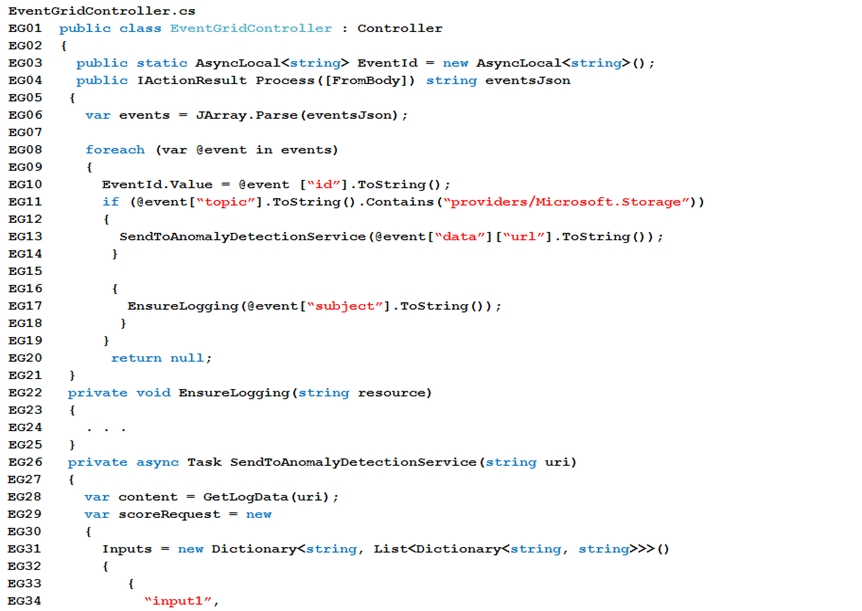
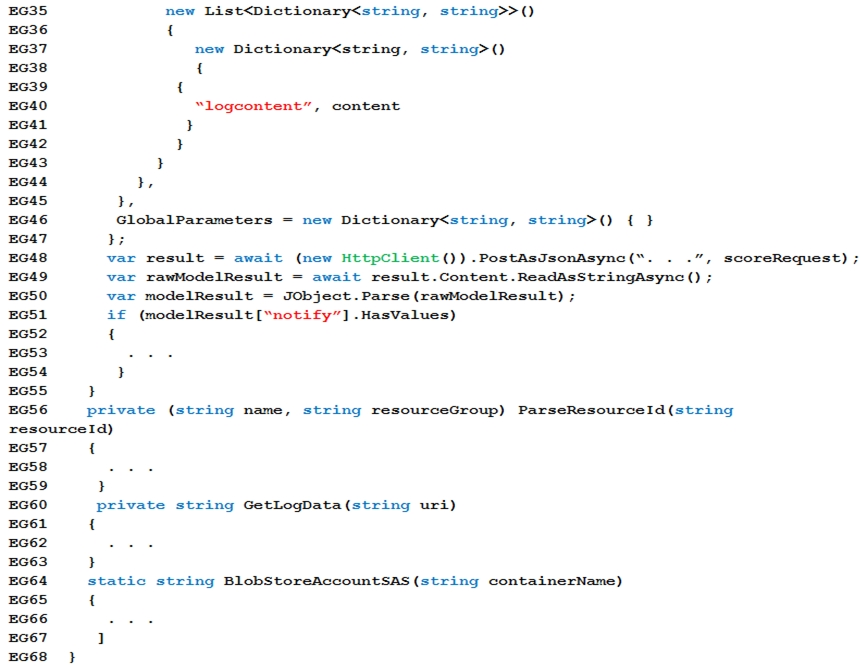
Relevant portions of the app files are shown below. Line numbers are included for reference only and include a two-character prefix that denotes the specific file to which they belong.
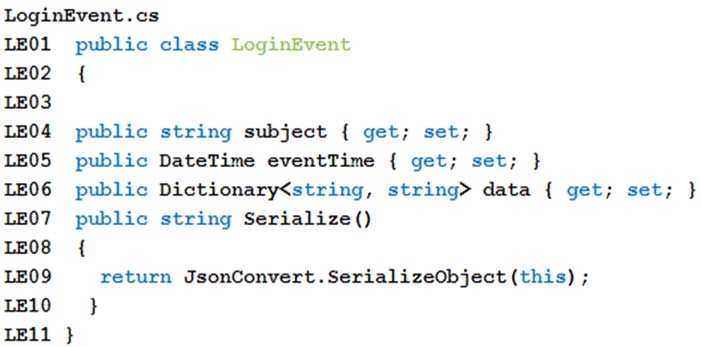
You need to resolve a notification latency issue.
Which two actions should you perform? Each correct answer presents part of the solution.
NOTE: Each correct selection is worth one point.
- A. Ensure that the Azure Function is set to use a consumption plan.
- B. Ensure that the Azure Function is using an App Service plan.
- C. Set Always On to false.
- D. Set Always On to true.
Answer : BD
Explanation:
Azure Functions can run on either a Consumption Plan or a dedicated App Service Plan. If you run in a dedicated mode, you need to turn on the Always On setting for your Function App to run properly. The Function runtime will go idle after a few minutes of inactivity, so only HTTP triggers will actually "wake up" your functions. This is similar to how WebJobs must have Always On enabled.
Scenario: Notification latency: Users report that anomaly detection emails can sometimes arrive several minutes after an anomaly is detected.
Anomaly detection service: You have an anomaly detection service that analyzes log information for anomalies. It is implemented as an Azure Machine Learning model. The model is deployed as a web service.
If an anomaly is detected, an Azure Function that emails administrators is called by using an HTTP WebHook.
References:
https://github.com/Azure/Azure-Functions/wiki/Enable-Always-On-when-running-on-dedicated-App-Service-Plan
Question 14
Note: This question is part of a series of questions that present the same scenario. Each question in the series contains a unique solution. Determine whether the solution meets the stated goals.
You develop an entertainment application where users can buy and trade virtual real estate. The application must scale to support thousands of users.
The current architecture includes five Azure Virtual Machines (VM) that connect to an Azure SQL Database for account information and Azure Table Storage for backend services. A user interacts with these components in the cloud at any given time
- Routing Service "" Routes a request to the appropriate service and must not persist data across sessions
- Account Service "" Stores and manages all account information and authentication and requires data to persist across sessions.
- User Service "" Stores and manages all user information and requires data to persist across sessions.
- Housing Network Service "" Stores and manages the current real-estate economy and requires data to persist across sessions.
- Trade Service "" Stores and manages virtual trade between accounts and requires data to persist across sessions.
Due to volatile user traffic, a microservices solution is selected for scale agility.
You need to migrate to a distributed microservices solution on Azure Service Fabric.
Solution: Create a Service Fabric Cluster with a stateless Reliable Service for Routing Service. Create stateful Reliable Services for all other components.
Does the solution meet the goal?
- A. Yes
- B. No
Answer : A
Explanation:
We should use stateful services when we want data to persist, and stateless service when data must not persist.
Note:
For stateful services, the Reliable Services programming model allows you to consistently and reliably store your state right inside your service by using Reliable
Collections.
A stateless service is one where there is no state maintained within the service across calls. Any state that is present is entirely disposable and doesn't require synchronization, replication, persistence, or high availability.
References:
https://docs.microsoft.com/en-us/azure/service-fabric/service-fabric-reliable-services-introduction
Question 15
Note: This question is part of a series of questions that present the same scenario. Each question in the series contains a unique solution. Determine whether the solution meets the stated goals.
You develop an entertainment application where users can buy and trade virtual real estate. The application must scale to support thousands of users.
The current architecture includes five Azure Virtual Machines (VM) that connect to an Azure SQL Database for account information and Azure Table Storage for backend services. A user interacts with these components in the cloud at any given time
- Routing Service "" Routes a request to the appropriate service and must not persist data across sessions
- Account Service "" Stores and manages all account information and authentication and requires data to persist across sessions.
- User Service "" Stores and manages all user information and requires data to persist across sessions.
- Housing Network Service "" Stores and manages the current real-estate economy and requires data to persist across sessions.
- Trade Service "" Stores and manages virtual trade between accounts and requires data to persist across sessions.
Due to volatile user traffic, a microservices solution is selected for scale agility.
You need to migrate to a distributed microservices solution on Azure Service Fabric.
Solution: Create a Service Fabric Cluster with a stateful Reliable Service for Routing Service. Deploy a Guest Executable to Service Fabric for each component.
Does the solution meet the goal?
- A. Yes
- B. No
Answer : B
Explanation:
We should use stateful services when we want data to persist, and stateless service when data must not persist.
References:
https://docs.microsoft.com/en-us/azure/service-fabric/service-fabric-reliable-services-introduction